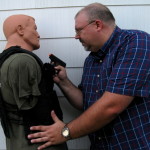 Few weapons are as frequently misunderstood as the pocket pistol. Neither as effective as even compact pistols, nor as useless as the tiny-caliber toys with which they are sometimes grouped, the pocket pistol is a niche weapon, a specialty tool that serves best within very constrained parameters. The reason so few people understand the pocket pistol is because few people understand the weapon’s realistic limitations.
Few weapons are as frequently misunderstood as the pocket pistol. Neither as effective as even compact pistols, nor as useless as the tiny-caliber toys with which they are sometimes grouped, the pocket pistol is a niche weapon, a specialty tool that serves best within very constrained parameters. The reason so few people understand the pocket pistol is because few people understand the weapon’s realistic limitations.
First, let’s talk about what a pocket pistol is and is not. Pocket pistols, to truly fit within a pocket comfortably and without creating an obvious bulge, must be smaller than, say, a snubnosed .38 special revolver. I know there are people who carry such revolvers in their pockets but, frankly, I’ve never understood how they do so without screaming to the world that they are armed. Pocket pistols must be very small to be light enough and compact enough to disappear in a pants pocket. If they are so heavy they cause the garment worn to sag noticeably, they are too heavy to qualify.
Pocket pistols can be of any caliber, from derringers in heavy full-sized loads, to automatics in .25 ACP, to revolvers in .22 and .22 Magnum. The caliber is not the determining factor; the size and weight of the gun overall is what matters. Two of the pocket pistols I’ve carried most often are the .22LR NAA Mini Revolver and the .25 ACP “Raven” (classified by some as a “Saturday Night Special”). You may find that different guns, in different calibers, work more or less well for you. That is a choice that hinges on the clothing style you wear, your body type, your size and weight, and of course the gun combined with these factors.
Carrying a Pocket Pistol
A pocket pistol may be carried “loose” in the pocket or in a holster that sits within the pocket. The latter method is preferable because it helps protect the gun from dust and debris while keeping the weapon oriented the same way no matter how you sit and move. A holster also prevents any portion of your pocket from snagging inside the trigger guard of the weapon. If you cannot carry your pocket pistol in a pocket holster, you need to consider how it is carried and how it is designed. An NAA Mini Revolver, for example, is a single-action revolver that cannot easily fire by accident (and has no trigger guard, for that matter). My little Raven .25 ACP, by contrast, is a striker-fired gun that, with a round in the chamber, would represent quite a risk of accidental discharge unless the safety is engaged. If you own such a weapon and the safety is not reliable, you should consider very strongly choosing a different weapon. A weapon you must carry chamber-empty may not be very useful if you don’t have both hands available to you as you deploy the pistol.
It should go without saying — but it doesn’t, for many — that if you carry a gun in your pocket, there must be nothing else in that pocket. You do not put keys, loose change, or other items in a pocket that also contains a weapon, be that weapon a gun or a folding knife clipped inside the pocket. There is too much potential for something to go wrong. Loose items could snag in or on the weapon, foul your draw, or otherwise hinder the deployment and use of the weapon. Choosing to carry a pocket pistol means devoting one of your pockets (typically your strong side front pocket, but not always) exclusively to space for that weapon.
The Power Issue
Regardless of how you carry a pocket pistol, you must clean it periodically to remove the lint and grit that always build up inside a gun that is carried in this way. A holster helps to slow that buildup, but it does not prevent it completely, so even a gun carried in a pocket holster must be checked and cleaned on a regular basis. Most of the time you can clean out debris without hauling out a cleaning kit to do it. Simply running a twisted tissue down the barrel a few times, or swabbing out the cracks and crevices of the gun with a dry Q-tip, should be sufficient for routine lint removal.
There is a myth, promulgated by some within the firearms community, that any bullet below [place arbitrary caliber here] simply will not kill you. Apparently if one is shot with a .22 or, if lucky, an anemic .25 ACP round, one is to demand angrily of one’s assailant, “Is that all you got? That didn’t hurt, you pansy.”
The reality is that even a small-caliber bullet has measurable utility for self-defense. That’s a polite way of saying that, no matter how small the bullet, if it enters my body I’m going to be very upset — and the introduction of that piece of metal to my person is going to affect, probably quite radically, my behavior immediately after that round strikes me. Small cartridges like the .25 ACP are not known for their stopping power, no, but they are preferable to nothing and, arguably, have shock value equal to or greater than stabbing an opponent (especially because repeated gun shots can have a cumulative, traumatic effect to the nervous system).
This is where the limitations of pocket pistols become critical. The typical pocket pistol is a launching mechanism for multiple small-caliber projectiles. To use these to maximum effect, you must use multiple rounds and you must choose your target carefully. Pocket pistols should be used to strike soft targets only, meaning those not protected by internal bone shields (the sternum, the ribs, the skull, the pelvis). This leaves with you the belly, the neck and throat, and the eyes or face.
The Mechanics of Pocket Pistols
A typical self-defense progression with a pocket pistol in your progression, therefore, looks like this:
You get your hands up and try to defuse the situation, maneuvering out of range of your assailant if you can. You make the decision to use lethal force when you judge that you are in credible threat of imminent and serious bodily injury and you cannot simply leave without being attacked as you flee.
You continue to maintain space with your off hand (or, if you are already grappling with someone who has made physical contact with you, you use your off hand to deal with the attack while maneuvering your gun-hand side away from the opponent. You reach into your pocket, grab your weapon, and prepare to draw it from the pocket. When you do, you will keep your arm indexed against your body and your elbow cocked back so that you have some idea of where the shots will go if you have to fire from this position.
With the gun drawn you have two choices. You can keep the weapon oriented low, indexed as you’ve drawn it, which means your target is your opponent’s belly (don’t shove it into the opponent unless you are using a weapon that can fire pressed against resistance — some automatics will go “out of battery” in such a scenario).
You can raise the weapon to target the throat and face. Firing into the throat can be done at an upward angle, almost as if you were shoveling an uppercut into the opponent. If you fire at the face, your opponent will see the weapon and may well instinctively grab for it. You’ve got to work fast to shoot him before he tries. It’s unlikely he’ll be able to pull some fancy disarm move, especially with such a small pistol (which offers little leverage when grabbed), but if he fouls your shot even a little, you will waste your round shooting him through the hand or in some other area less vital than the face or throat.
You may choose to brace your opponent with your off hand at close range. This is extremely dangerous because of the risk you may shoot through the opponent and into your own limb.As practiced in close-quarters combat, your arm should be at an angle and a level that puts it out of the effective firing line of your weapon (such as high at his head and shoulder while you fire downward, in this case into the belly). Never grab the back of the head and shoot for the throat or face.
Your goal, when deploying and choosing your target, is to shoot your pocket pistol empty. You must fire and keep firing until you’re out of rounds or until your target is neutralized (until he stops aggressing). Most pocket automatics can be emptied very quickly. A single .25 or .32 caliber bullet may not seem like much, but five of them delivered in rapid succession is something else again.
That said, be prepared for the possibility that the fight will go on after your weapon is empty. You may not put him down easily with such an underpowered weapon and you would be stupid to expect even a full magazine to drop him. This will be the time to use whatever unarmed combatives methods you train in order to fight your assailant off you now that he is wounded and (hopefully) less capable of fighting back. Trauma of the type you have inflicted may well trigger your opponent’s desperation switch and he may fight back that much more viciously because he fears the injuries he is incurring. Fight hard to prevent him from overwhelming you and taking you with him.
Utility and Reality
The pocket pistol has been dismissed as next to useless — a “talisman” that people carry because they want to carry a gun, but are unable or unwilling to carry a “real” weapon. While not nearly as effective as larger handguns, pocket pistols are serious self-defense tools. Used at extremely close range to target the body’s most vulnerable areas, they can neutralize or debilitate an assailant relatively quickly. This can stack the odds in your favor in the gamble that is self-defense. This is the definition of a force multiplier for self-defense.
Easily carried and concealed, the pocket pistol is the gun most likely to be with you when you need it. If you own larger handguns that you’ve left at home in a safe or locked inside your car, even a small-caliber pistol can make the difference between success and failure in self-defense. Remember this and you can keep the pocket pistol in its proper perspective.
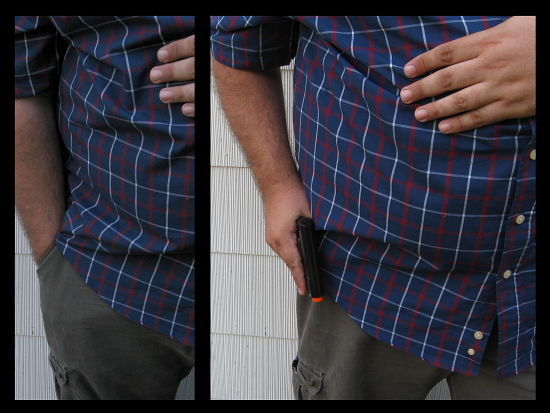
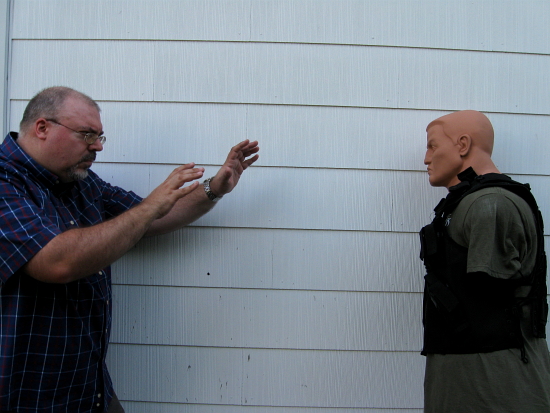
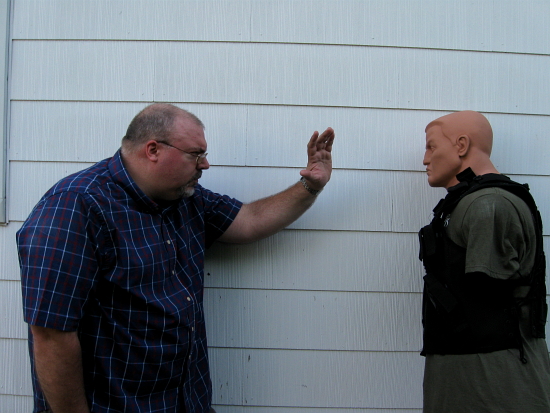
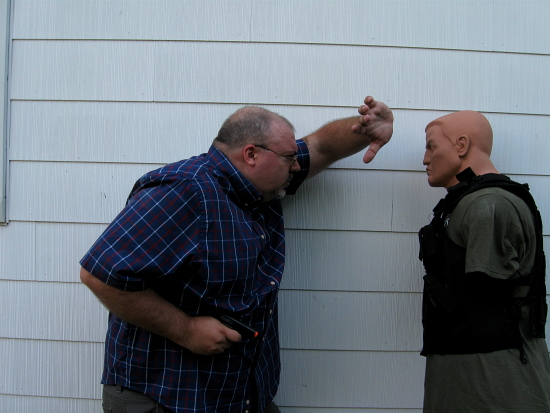
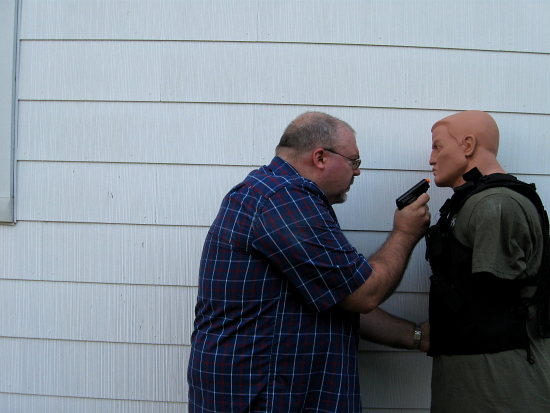
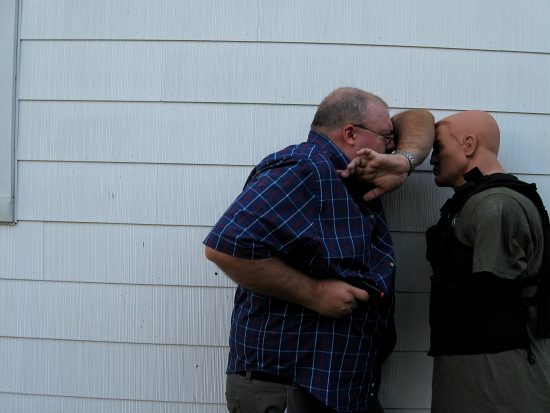
i carried this wonderful little Beretta .22 for years knowing full well its limitations. But i loved the ease of carry and knew *though some of my friends laughed at me* it could full well “do it’s job” if the situation presented itself. I would advise anyone wanting to carry one of these pocket guns to do so with the understanding that it is not an end all to a physical conflict. As Phil stated quite well ” You may not put him down easily with such an underpowered weapon and you would be stupid to expect even a full magazine to drop him. This will be the time to use whatever unarmed combatives methods you train in order to fight your assailant off you now that he is wounded and (hopefully) less capable of fighting back”
to me this is the perfect mindset for keeping a gun like this on your person.
wonderfully written as always.
Some very good points about small pocket type pistols and carrying them safely. Any handgun you actually carry is better then the ultimate handgun you have in your closet.
For years, I carried a little .380 AMT semi auto because it was so handy. I could slip it into a jacket or pocket very easily. When I sensed danger, I put my hand in my pocket and flicked the safety off. A situation arose years ago that called for drawing the gun because a group of street toughs was threatening my wife and I on a dark city street. The situation was resolved peacefully but this forced me to re evaluate my carry gun selection. My little .380 had insufficient power to reliably stop multiple attackers. My AMT had a 1.5” barrel, only had 6 rounds and occasionally jammed at the range.
This began my search for a more better hand gun and carry system. The following are my thoughts on selection of a handgun and carry system.
First, you should consider the caliber and power level. Since you can only legally employ lethal force when you are in fear of eminent crippling or lethal force, I think you should select a caliber of sufficient power to STOP THE ATTACK with one shot center mass.
Many studies from Evan Marshall and the FBI suggest that a minimum of 400 ft/lbs of energy minimum is required. This puts you in the range of .38 Special with special ammunition and 9 Mill P plus P with defensive loadings minimum. My favorite is the S & W .40 caliber with 550 ft/lbs
You must of course also practice with your firearm for accuracy and reliability. Some Semi automatic manufacturers suggest firing at least 500 rounds of your carry ammunition for reliability testing.
The next thing to think about in the search for the perfect carry gun is size and weight. Size does matter and this is where the big compromise starts. A small handgun will be easy to carry and conceal, probably light in weight and you will likely carry this firearm more often. The downside is that a small size and weight will recoil much more for a given caliber, have less capacity and the short barrel will be more difficult to shoot accurately. What this means to me is that in a sufficiently powerful gun caliber, It will be an inaccurate, nasty little gun to shoot and you will not want to spend much time at the range with it. I personally like to put holes in things at the range.
Firearms material and design is a whole new discussion. I will say revolvers are l generally less fussy about ammunition.
How to carry your Defensive handgun?
Loose in a field jacket with big pockets and flap can work, also loose in a Tactical type Vest with Velcro closure or clip in holster. I guess the concept here is baggy clothes can work for you if you are not fashion conscious. I ran across an interesting concept in a great book called SIXGUNS by Elmer Keith. Mr. Keith carried a heavy six-gun for approx 65 years was an extraordinary long
Distance handgun shooter, Big game hunter and quick drawn specialist. A gun fighter friend of Mr. Keith carried two .45 caliber colts in his pockets. He had cut the barrels down to the frame, removed the triggers and rewelded the
Hammer spur lower. This is called a slip gun because to fire this handgun, you pulled the hammer back with your thumb and slipped your thumb off to fire. This was popular with gun fighters because it was simple and reliable. His wife sewed large pockets in his dress pants. If he were in an uncomfortable spot, he would reach into his pockets and hold the hammers back with his thumbs. His wife wore a lot of expensive jewelry but people knew that even if they shot the gentleman, he would “DROP THE HAMMERS” on them. I guess the concept here would be to select the gun you need and change your wardrobe.
If you like the Tactical vest look, Check out the 5.11 vest. It looks very L.L.Bean and you can comfortably carry a full size handgun with extra clips or speed loaders, tactical flashlight and personal gear. You can carry right in the large Velcro closed pockets or snap in special holsters available from 5.11.
If you want to carry a larger frame handgun, a well-designed belt or shoulder holster with vest or light jacket is a good choice. A Holster that carries your handgun high on the belt is good for concealed carry under a light vest or jacket. Bianchi has a wide variety of holsters designed for law enforcement. One of my favorites is the Bianch 7105 Cruiser. Designed for administrative personnel. . It carry’s the gun high on your belt and works well in a cross draw mode in your car. A good holster should secure the holster to the belt firmly. I personally do not like clip-on holsters. Clip on Ties are great in a bar room brawl. If someone snatches your tie, they will not take you down with it. On the other hand, if they snatch your clip-on holster, you just lost your handgun. Not a good thing. Also, a good belt holster can offer gun retention. Several Bianchi holsters offer special clip type features that allow you to pull the gun but prevent your assailant from grabbing it. This is popular with law enforcement and part of their gun retention training. The key factor is, you must maintain control of your handgun.
Shoulder holsters are bulky but a secure way to carry a medium framed, long barreled handgun with a substantial power level. Try the “SUPERMAN” carry. Put on a “T’ shirt, your shoulder holster and your L.L.Bean Heavy shirt with snap buttons. To get to the firearm, rip open your shirt with one hand and draw with the other. This works best with right-handed people, as shirts are usually right buttoned.
Fanny packs for men and special pocket books for women are handy, look sporty and can carry all of your equipment. Check out Bianchi and 5.11 gear.
My personal favorite is THUNDERWEAR. For hot climates, it’s a great approach to carrying a small to medium sized handgun. “Thunderwear” It is a Velcro Poach type holster that you wear over your Shirt/T Shirt but under your pants. The gun is positioned over your crotch and under your belt line. You can wear this under joggers or a bathing suit. Just don’t go swimming. You can nicely conceal a small snub-nosed revolver or a small framed Semi-auto in this rig. . In use, you just reach in and grab the firearm.
My 4” barreled .40 caliber S & W with 13 rounds is slightly large for this type of carry but it can work. Sitting in the car with this rig can be painful. A small hammerless revolver in .357/.38 plus P caliber with a 2.5 inch barrel might be perfect. I am still trying different combinations.
Charles E Davis
I think a bullet in the throat would be a pretty good deterrent.
Good article Phil
When I have to go “unarmed” I carry the Beretta Bobcat along with an assisted opening pocket knife . I would not like to be on the receiving end of either.
Good Read.. The only thing that struck me as being off was your comment about the .38 revolvers. I carry a S&W 642 and nobody knows I have it even when I’m wearing skinny Jeans. If there’s no holster there might be a slight bulge where the chamber is, but this actually helps to offset the profile of the gun.
People don’t usually assume that someone is carrying a gun unless they have reason to think otherwise. Wallet/car keys is what most people assume.
Boberg Arms makes a bullpup 9mm+P pocket pistol that recoils like a .380acp. Very small compact design with a 3.35″ barrel. I carry in the front jeans pocket with an empty chamber, pistol inverted with the base of the grip forward and barrel pointed up. The advantage is that you can carry with tight jeans because you need only hook the trigger guard with your index finger in the pocket. Pull the gun out until only the grip remains in your pocket then rotate the barrel forward and the grip into your palm. The off hand can rack the slide while the gun is still at groin level. I get a lot of people who are against carry with an empty chamber because they say I may not have 2 hands available to get the gun into action. The truth is that most concealed carry options require a second hand to pull back clothing to assist in the draw.